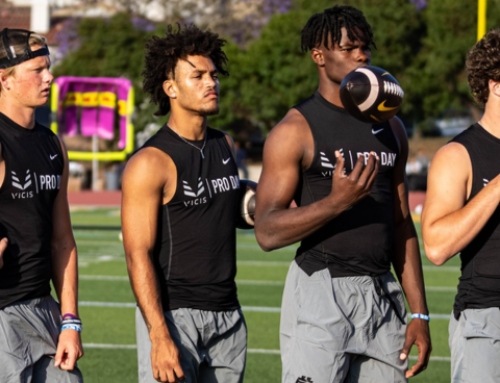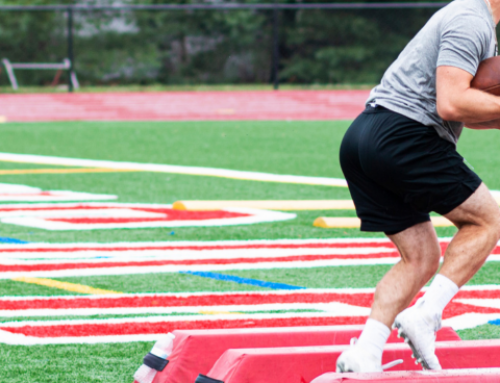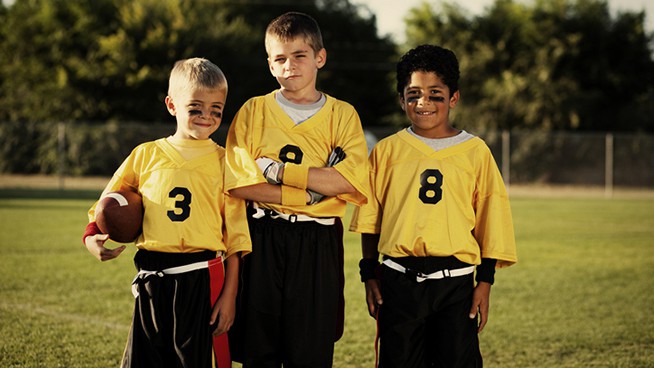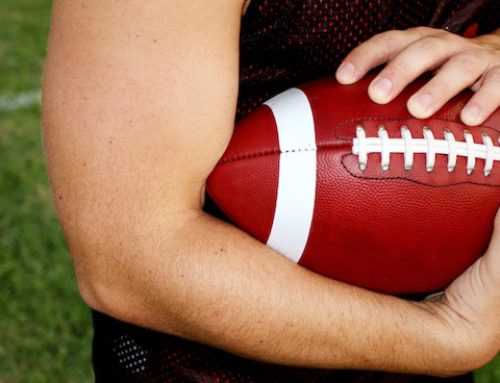How to Play Flag Football
Flag Football on the Rise
Flag football is a variant of the beloved contact sport, American Football. However, in complete contrast to Football, flag football is utterly non-contact, with penalties associated with contact and even rough play. Because of this contact-free play, flag football has risen in popularity for both parents and young athletes with the drastically decreased risk of injury and minimal equipment requirements to play the game.

Why Flag Football Has Grown In Popularity
First and foremost, parents love the fact that flag football is non-contact. Are there still some risks of injury associated with the game? Of course, as with any sport, the risk is drastically reduced because of the lack of contact. This allows parents more peace of mind with allowing their child to participate in the sport.
Football is a game all about functional strength, mammoth size, and explosive speed. Flag football is catered more towards developing fundamentals and strengthening skills necessary to play the game without teaching proper tackling techniques. Flag football allows a young player a more solid, broad foundation of coordinated movements.
Football is generally seen as a male-dominated sport even though are some women’s leagues, but flag football is for everyone. Teams can be of any gender, allowing for greater camaraderie amongst the players.
Different Rules For Flag Football
Flag football is rather simple in its principle of contact-less Football, and for the most part, various leagues rules share similarities. However, some rules do differ in their scale of players, for instance, length of game, or even field design.
Generic Rules For Flag Football
These rules are rather common across any leagues’ rules:
Game Objective:
- In flag football, teams of 5 – 8 players attempt to score points against one another through various plays, runs and passes, to score touchdowns and extra points. The team with the most points at the end of regulation time is declared the winner.
- Overtime is extra time and can range anywhere from four extra downs to score or extra point attempts conducted in shootout fashion.
- The team with the most points after each team has an overtime possession is declared the winner.
- Overtime play continues until a winner is declared.
Field Playing Area:
- A flag football field can range anywhere from 60 – 80 yards in length and 20 – 30 yards in width.
- A goal-line exists at each end of the field, 10 yards from each end, creating the endzone.
- The centerline exists in some fields as the direct center of the field.
- Some leagues have no run zones five yards from each goal line and centerline.
Equipment Needed:
Football:
-
-
- Balls vary in size depending on the age of players.
- Can range anywhere from peewee to NFL regulation-sized pigskin.
-
Flags
- Must be either Velcro or attached to a detachable belt
-
- Must have two flags on either hip to be pulled
- Can vary in color and style
- Must be worn over the shirt
- Shirt must be tucked in or worn in such a way so as to not interfere with the pulling of flag
-
Uniform
- Some leagues require the use of specific shirts and flags
- Some leagues require the use of mouthguards
- Cleats or athletic shoes
How to Start The Game
- A coin toss determines who receives and who kicks off first
- Kickoffs occur at the beginning of each half and after each score
- All kicks are performed through punting
- Free kicks are prohibited
- Teams change ends at half-time
- Halves range from 15- 25 minutes
- Can range from 10 – 12 minutes during tournament play for quicker games
- Halves range from 15- 25 minutes
Game Time:
- The start of each play occurs at the snap of the ball. The ball must be snapped in an exchange from the Center to the Quarterback.
- Can be done with the Quarterback under Center or in shotgun formation.
- All other players must remain still until the ball is snapped.
- One forward pass behind the line of scrimmage is legal.
- Runs and hand-offs are legal.
- Quarterbacks are prohibited from sneaking in some leagues.
- Defenders looking to sack the Quarterback must remain in a zone 7 yards away from the line of scrimmage.
- Running backs who receive hand-offs can be “tackled” as soon as the hand-off occurs.
- A player is ruled “down” or “tackled” when their flag is pulled.
- The offense, team with the ball, has 4 downs to achieve a first down after moving the ball 10 yards down the field.
- If the offense fails to achieve a first down, a turnover is declared.
- In some leagues, the defense, team without the ball, takes over as offense from the spot of the offense’s last position.
- In others, the offense can punt on 4th down.
- And in others, the defense takes over on their own 5 or 7 yard-line.
- If the offense fails to achieve a first down, a turnover is declared.
- A down is the time from one tackle to the next.
- The line of scrimmage is the imaginary line the offense utilizes as the start of each play and where the Quarterback or player cannot cross before attempting a forward pass.
- If a player loses his flag belt either legally or illegally during a down and gains possession of the ball, the play is considered dead, and the ball is placed at the spot of initial possession.
- An illegal loss of flag is when a player intentionally pulls another player’s flag who doesn’t have the ball.
- This results in a penalty of 10-yards.
- Ball carriers are also not allowed to guard their flags. Stiff arms are prohibited.
- An illegal loss of flag is when a player intentionally pulls another player’s flag who doesn’t have the ball.
- During punts, the defense is prohibited from crossing the line of scrimmage to protect the punter.
- Other players of the punting team must be on the line of scrimmage and cannot move until the ball is punted.
- If the punted ball touches a player after being kicked then hits the ground, the ball is dead, and the receiving team’s offense takes over at the spot of ruled dead.
- Players can make a backward pass at any time. However, fumbles are prohibited.
- If a player loses possession of the ball at any time, the ball is ruled dead, and the offense continues from the spot of ruled dead.
- The offense can attempt one forward pass from behind the line of scrimmage each down.
- Any forward pass over the line of scrimmage is declared illegal.
- A defender can intercept the forward pass and their offense takes over after the interceptor is tackled.
- Any receiver must complete the catch of the forward pass with at least one foot in bounds.
- If a receiver and defender catch a forward pass simultaneously, possession is given to the offense.
- Touchdowns and Other Scoring Opportunities:
- A touchdown occurs when a ball carrier cross the goal line while in possession of the ball.
- A touchdown is worth 6 points.
- Extra point attempts can be made after a touchdown occurs.
- Teams can choose between a 1, 2, or 3 extra-point attempts.
- 1-point extra attempt is a play after touchdown beginning on the 3-yard line.
- 2-point extra attempt is a play after touchdown beginning on the 10-yard line.
- 3-point extra attempt is a play after touchdown beginning on the 20-yard line.
- Safeties are worth 2 points
- A safety occurs when an offensive player is tackled behind their own goal line in their own end zone.
- The 2 points are awarded to the defensive team.
- The offense must kickoff to the defense.
Go Pro?
Professional leagues have begun to be developed in some capacity with some leagues having been created in America and internationally in countries such as Canada and South Africa. These leagues also have their own rules with two more sets of flag football rules listed below:
AFFL Rules
The American Flag Football League (AFFL) is a professional flag football league dedicated to respectful but competitive play. Some differing rules of note are:
- 7 on 7 game-play with a 12-man roster.
- 60-minute complete game played in four 15-minute increment quarters.
- Clock never stops except for the last two minutes of the fourth quarter
- Only one lateral allowed per play except for throw offs and punt returns.
- Defense must wait 2 seconds before rushing, which then allows the quarterback to be able to rush where he otherwise could not.
- Quarterback has four seconds to pass or run.
- Defense can rush 10 times a game, 5 times a half, without waiting 2 seconds.
- Touchdowns under 50 yards are worth 6 points whereas touchdowns over 50 yards are worth 7 points
- Penalties generally allow a free play or a loss of down rather than
NFL Flag Rules
The National Football League recognizes flag football’s popularity with its own league. Some differing rules of note include:
- Laterals are prohibited.
- Direct hand-offs are permitted.
- Center sneak plays are prohibited.
- 5 on 5 game-play.
- There are no kickoffs.
- Offenses start on their own 5-yard line and has four downs to cross midfield for a first down.
- 28-point mercy rule.
- If a team leads by 28 points, the game is declared over.
- Players cannot hurdle or jump to avoid another player.
- Utilizes 5 yard no run zones before each end zone and on either side of the centerline.
Get Out and Play!
Athletes of all ages and sizes can enjoy the game of flag football. The rules are similar to actual Football, just remove all the risk of grave injury from high-impact contact tackling. With the broad range of rules, there are great guidelines for adapting the rules to one’s league and game that fit best at the time.
For full list of AFFL Rules and NFL Flag Rules.
RECOMMENDED FOR YOU
How to Play Flag Football
Flag Football on the Rise
Flag football is a variant of the beloved contact sport, American Football. However, in complete contrast to Football, flag football is utterly non-contact, with penalties associated with contact and even rough play. Because of this contact-free play, flag football has risen in popularity for both parents and young athletes with the drastically decreased risk of injury and minimal equipment requirements to play the game.

Why Flag Football Has Grown In Popularity
First and foremost, parents love the fact that flag football is non-contact. Are there still some risks of injury associated with the game? Of course, as with any sport, the risk is drastically reduced because of the lack of contact. This allows parents more peace of mind with allowing their child to participate in the sport.
Football is a game all about functional strength, mammoth size, and explosive speed. Flag football is catered more towards developing fundamentals and strengthening skills necessary to play the game without teaching proper tackling techniques. Flag football allows a young player a more solid, broad foundation of coordinated movements.
Football is generally seen as a male-dominated sport even though are some women’s leagues, but flag football is for everyone. Teams can be of any gender, allowing for greater camaraderie amongst the players.
Different Rules For Flag Football
Flag football is rather simple in its principle of contact-less Football, and for the most part, various leagues rules share similarities. However, some rules do differ in their scale of players, for instance, length of game, or even field design.
Generic Rules For Flag Football
These rules are rather common across any leagues’ rules:
Game Objective:
- In flag football, teams of 5 – 8 players attempt to score points against one another through various plays, runs and passes, to score touchdowns and extra points. The team with the most points at the end of regulation time is declared the winner.
- Overtime is extra time and can range anywhere from four extra downs to score or extra point attempts conducted in shootout fashion.
- The team with the most points after each team has an overtime possession is declared the winner.
- Overtime play continues until a winner is declared.
Field Playing Area:
- A flag football field can range anywhere from 60 – 80 yards in length and 20 – 30 yards in width.
- A goal-line exists at each end of the field, 10 yards from each end, creating the endzone.
- The centerline exists in some fields as the direct center of the field.
- Some leagues have no run zones five yards from each goal line and centerline.
Equipment Needed:
Football:
-
-
- Balls vary in size depending on the age of players.
- Can range anywhere from peewee to NFL regulation-sized pigskin.
-
Flags
- Must be either Velcro or attached to a detachable belt
-
- Must have two flags on either hip to be pulled
- Can vary in color and style
- Must be worn over the shirt
- Shirt must be tucked in or worn in such a way so as to not interfere with the pulling of flag
-
Uniform
- Some leagues require the use of specific shirts and flags
- Some leagues require the use of mouthguards
- Cleats or athletic shoes
How to Start The Game
- A coin toss determines who receives and who kicks off first
- Kickoffs occur at the beginning of each half and after each score
- All kicks are performed through punting
- Free kicks are prohibited
- Teams change ends at half-time
- Halves range from 15- 25 minutes
- Can range from 10 – 12 minutes during tournament play for quicker games
- Halves range from 15- 25 minutes
Game Time:
- The start of each play occurs at the snap of the ball. The ball must be snapped in an exchange from the Center to the Quarterback.
- Can be done with the Quarterback under Center or in shotgun formation.
- All other players must remain still until the ball is snapped.
- One forward pass behind the line of scrimmage is legal.
- Runs and hand-offs are legal.
- Quarterbacks are prohibited from sneaking in some leagues.
- Defenders looking to sack the Quarterback must remain in a zone 7 yards away from the line of scrimmage.
- Running backs who receive hand-offs can be “tackled” as soon as the hand-off occurs.
- A player is ruled “down” or “tackled” when their flag is pulled.
- The offense, team with the ball, has 4 downs to achieve a first down after moving the ball 10 yards down the field.
- If the offense fails to achieve a first down, a turnover is declared.
- In some leagues, the defense, team without the ball, takes over as offense from the spot of the offense’s last position.
- In others, the offense can punt on 4th down.
- And in others, the defense takes over on their own 5 or 7 yard-line.
- If the offense fails to achieve a first down, a turnover is declared.
- A down is the time from one tackle to the next.
- The line of scrimmage is the imaginary line the offense utilizes as the start of each play and where the Quarterback or player cannot cross before attempting a forward pass.
- If a player loses his flag belt either legally or illegally during a down and gains possession of the ball, the play is considered dead, and the ball is placed at the spot of initial possession.
- An illegal loss of flag is when a player intentionally pulls another player’s flag who doesn’t have the ball.
- This results in a penalty of 10-yards.
- Ball carriers are also not allowed to guard their flags. Stiff arms are prohibited.
- An illegal loss of flag is when a player intentionally pulls another player’s flag who doesn’t have the ball.
- During punts, the defense is prohibited from crossing the line of scrimmage to protect the punter.
- Other players of the punting team must be on the line of scrimmage and cannot move until the ball is punted.
- If the punted ball touches a player after being kicked then hits the ground, the ball is dead, and the receiving team’s offense takes over at the spot of ruled dead.
- Players can make a backward pass at any time. However, fumbles are prohibited.
- If a player loses possession of the ball at any time, the ball is ruled dead, and the offense continues from the spot of ruled dead.
- The offense can attempt one forward pass from behind the line of scrimmage each down.
- Any forward pass over the line of scrimmage is declared illegal.
- A defender can intercept the forward pass and their offense takes over after the interceptor is tackled.
- Any receiver must complete the catch of the forward pass with at least one foot in bounds.
- If a receiver and defender catch a forward pass simultaneously, possession is given to the offense.
- Touchdowns and Other Scoring Opportunities:
- A touchdown occurs when a ball carrier cross the goal line while in possession of the ball.
- A touchdown is worth 6 points.
- Extra point attempts can be made after a touchdown occurs.
- Teams can choose between a 1, 2, or 3 extra-point attempts.
- 1-point extra attempt is a play after touchdown beginning on the 3-yard line.
- 2-point extra attempt is a play after touchdown beginning on the 10-yard line.
- 3-point extra attempt is a play after touchdown beginning on the 20-yard line.
- Safeties are worth 2 points
- A safety occurs when an offensive player is tackled behind their own goal line in their own end zone.
- The 2 points are awarded to the defensive team.
- The offense must kickoff to the defense.
Go Pro?
Professional leagues have begun to be developed in some capacity with some leagues having been created in America and internationally in countries such as Canada and South Africa. These leagues also have their own rules with two more sets of flag football rules listed below:
AFFL Rules
The American Flag Football League (AFFL) is a professional flag football league dedicated to respectful but competitive play. Some differing rules of note are:
- 7 on 7 game-play with a 12-man roster.
- 60-minute complete game played in four 15-minute increment quarters.
- Clock never stops except for the last two minutes of the fourth quarter
- Only one lateral allowed per play except for throw offs and punt returns.
- Defense must wait 2 seconds before rushing, which then allows the quarterback to be able to rush where he otherwise could not.
- Quarterback has four seconds to pass or run.
- Defense can rush 10 times a game, 5 times a half, without waiting 2 seconds.
- Touchdowns under 50 yards are worth 6 points whereas touchdowns over 50 yards are worth 7 points
- Penalties generally allow a free play or a loss of down rather than
NFL Flag Rules
The National Football League recognizes flag football’s popularity with its own league. Some differing rules of note include:
- Laterals are prohibited.
- Direct hand-offs are permitted.
- Center sneak plays are prohibited.
- 5 on 5 game-play.
- There are no kickoffs.
- Offenses start on their own 5-yard line and has four downs to cross midfield for a first down.
- 28-point mercy rule.
- If a team leads by 28 points, the game is declared over.
- Players cannot hurdle or jump to avoid another player.
- Utilizes 5 yard no run zones before each end zone and on either side of the centerline.
Get Out and Play!
Athletes of all ages and sizes can enjoy the game of flag football. The rules are similar to actual Football, just remove all the risk of grave injury from high-impact contact tackling. With the broad range of rules, there are great guidelines for adapting the rules to one’s league and game that fit best at the time.
For full list of AFFL Rules and NFL Flag Rules.










